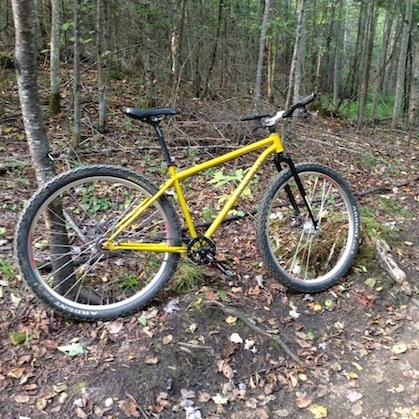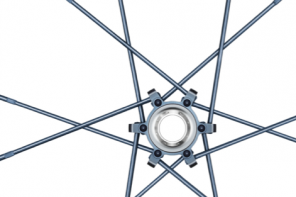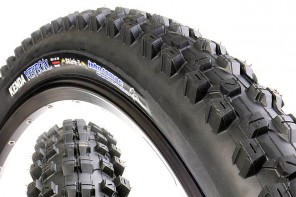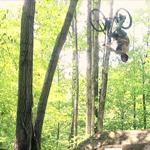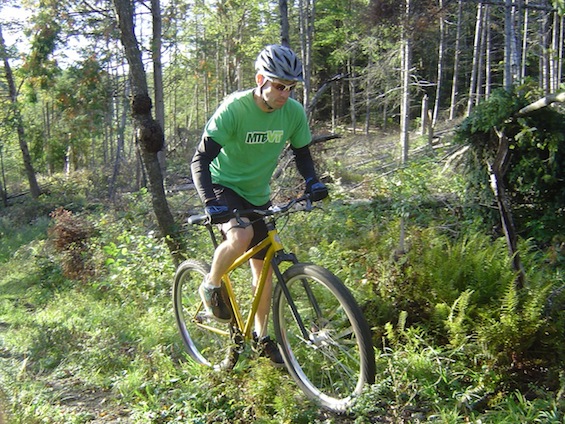
Vassago started making frames back in 2005 with a nearly exclusive focus on 29 inch wheels. The company has gone through a bit of a rough time in recent years, but it has had some new life breathed into it with a change in ownership last fall. Throughout their past difficulties, they’ve managed to develop quite a following, particularly with their Jabberwocky frame. It’s great to see the company bounce back and start offering improvements to what may be their best known model.
I acquired their new Jabberwocky frame through Onion River Sports in Montpelier. They are the only Vassago dealer in Vermont at this time and were extremely helpful with working out the details of a warranty issue with my previous frame. Likewise, Vassago was excellent to deal with. There were rumors going around about the prior management being difficult to work with but, based on my experience, this is no longer even remotely the case now.
Now that I’ve had the bike in hand, so to speak, I’ve spent an inordinate amount of time on it, giving it a thorough working over. I’ve climbed, descended, slogged through mud, jumped and generally man-handled it through most of my favorite trails up here in Northeastern Vermont. Now that my legs are pretty sore, let’s dig into the details.
Features:
- Vassago 29er proprietary Rtech butted tubing
- Cast horizontal dropouts
- Internal, forward facing Jabbernutz tensioners (included) allow the use of a quick release hub
- Hydro-style cable guides
- 44mm Headtube to allow the use of tapered forks
- ISO standard disc brake mounts allow rear tire changes without messing with brake caliper
- Available Vassago Gear Plug to run a rear deraileur with perfect wheel alignment
- Vassago Original Wet Cat Geometry
- MSRP frame $519.99
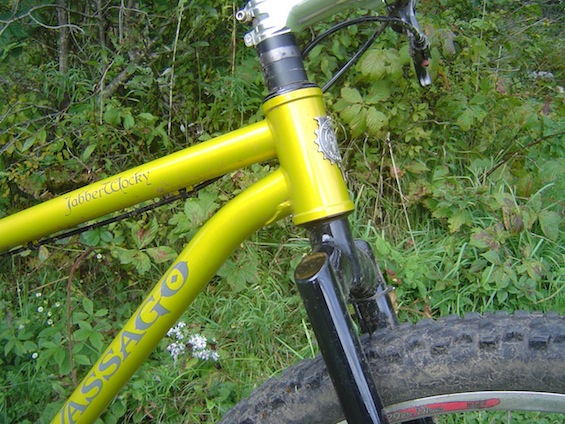
This is the first update of the Jabberwocky since the new owners have taken the reins at Vassago. The bike continues the same basic qualities of the original Jabberwocky, only with some refinements. For those familiar with the Jabberwocky, here’s what’s new with this updated version:
- The down tube is now curved, instead of the old raised attachment on the head tube.
- The head tube is made with a 44mm diameter, accommodating forks with either tapered steerer tubes or traditional 1-1/8″ steerers.
- The bottom bracket shell is now 73mm wide instead of 68mm.
- The frame tubes are now made using size-specific butted tubing with minor improvements to the butting profile.
If you’ve spent many hours on a Jabberwocky in the past, you know what you’re in for here. None of the great things that made a Jabber a Jabber have changed. If you haven’t been so fortunate, then read on.
Starting with the basics, the frame is made of chromoly steel using their own “Rtech” tubing. With everyone looking at using carbon fiber for just about everything and the nearly ubiquitous use of aluminum for bike frames, steel is often not given the serious consideration it still deserves. I’m not going use this space to attempt to convince anyone that “steel is real” or any such nonsense, but I will say that it can be used to create a great riding bike. The frame is very solid and the welds appear to be clean and very consistent.
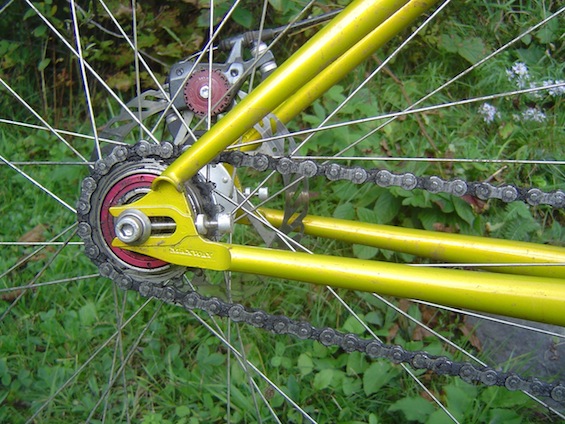
The rear of the bike uses horizontal dropouts or, more accurately, track ends, with tensioners to take care of wheel holding duties. I’ve been using a bolt-on White Industries ENO hub and it has performed flawlessly with the frame – no sliders or other tensioning mechanisms to slip or mess with while out on the trail. It even works well with a quick release hub and a good skewer. The simplicity of the system, if you want to call it that, is a major plus in my book. According to Vassago, the rear triangle has space to accommodate a ”muddy 2.3″ inch tire. It would be nice if it could be just a little bit wider as I really like to run fat tires. I’ve found that I can comfortably get away with a 2.4″ Maxxis Ardent as long as the axle isn’t jammed all the way forward in the stays.
Perhaps the most distinctive aspect of the Jabberwocky is the frame’s geometry. It is also the main reason I managed to discover the Jabber to begin with. Having short legs and a long torso for my height, I was on a quest to get an 18 inch frame with the longest top tube I could find. At 24.2 inches, the Jabber’s roomy cockpit delivered pretty well in this department. What I didn’t bargain for was how awesome this bike would handle due to their unique combination of angles. Vassago calls this their WetCat geometry: a long wheel base, relaxed head tube angle (71 degrees), steep seat tube angle (73.5), and a relatively low bottom bracket. When I first rode one, it really did feel long, low and fast. You truly do get the sensation that your weight is lower, like you’re sitting between the wheels. What’s more surprising is that when maneuvering the bike in tight single-track it feels very nimble – much more than you’d expect considering the longer wheel base. When the trail turns up, this bike turns into a monkey. I almost never lose traction before running out of power and the front end is glued to the ground even when climbing seated. It is the best climbing bike I’ve owned – geared or single-speed.
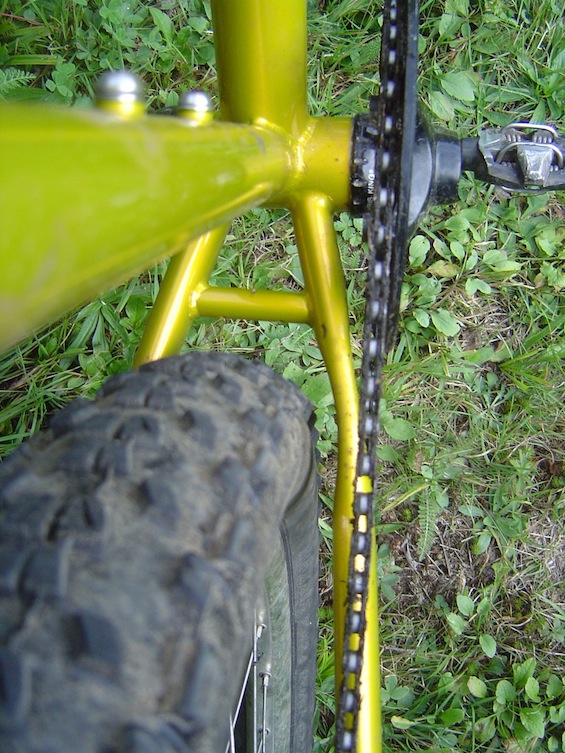
There are only a couple of minor, negative things that I’ve found resulting from the Jabberwocky’s geometry. The first is that it is a little more difficult to get the front wheel off the ground just by leaning back and pulling on the bars (the “manual”). With some bikes, I’m able to just pull up and loft the front end forever. With the Jabber, it can still be pulled up easily enough to deal with logs or mud holes, but getting it back to the balancing point is more of a chore. The front end is still very maneuverable and can be flicked around pretty easily in tight or technical terrain so it’s not proven to be unbearable. The second issue is that the lower bottom bracket took a while for me to adjust to. At first, I was frequently hitting my pedals on rocks when powering through corners but I eventually adapted to the difference.
If you love riding a single-speed, this bike makes few compromises. It makes for an excellent racing machine, even if it isn’t in the fly weight category – the extra few ounces of steel over other materials are hardly noticeable. For some reason, this frame seems just slightly quicker or more lively than the earlier Jabberwocky frames I’ve ridden. This may be due to the changes in the tubing or it might just be the “dehydration yellow” paint job playing Jedi mind tricks on me. Regardless, it’s a bike with phenomenal handling – especially when paired with Vassago’s Odis fork.

Rating:
- Innovation: 2/2
- Function: 2/2
- Aestheitcs: 2/2
- Features: 2/2
- Quality/Price: 2/2
- Overall Rating: 10/10
Pros:
- Amazing traction, climbs like a monkey
- Single-speed specific design. There are no cable guides for anything other than a rear brake
- Great handling geometry
- Awesome when paired with a rigid fork
- Long top tube gives plenty of room to stretch out. Great on long rides
- Horizontal dropouts – no messing with bolts and sliders
- Price. There are few frames out there of this quality at this price point
Cons:
- The rear triangle has limited space for really fat tires
- Difficult to “manual”
- Low bottom bracket height can mean more pedal strikes, at least initially
- The frame is designed around an 80mm fork, if you must have squishiness. A fork with 100mm travel or greater does slow the steering down ever so slightly.
- Does not convert easily to a geared setup (Why would you want to do that?!?)
- Doesn’t come in white. Colors are limited to Black and Gold.
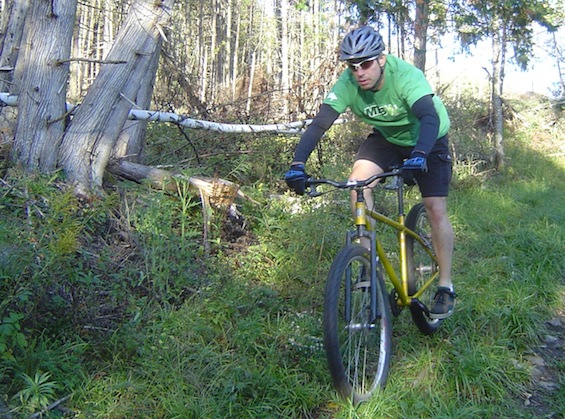
Specs:
- Frame Material: Vassago Rtech tubing
- Headset: 44mm inset
- Seatpost: 27.2
- Bottom Braket: 73mm shell, standard BSA
- Disc Brakes: Standard ISO
- Dropouts: Cast horizontal with internal forward facing Jabbernutz tensioners
- Rear Spacing: 135mm
- Front Derailleur: Not on a Jabber!!
- Rear Derailleur: Standard (with optional Gear Plug2)
- Rigid Fork: Vassago Odis
- Squishy Fork: 80mm recommended for best handling, 100mm do-able
- Tire Clearance: Muddy 2.3s
For more wordsmithing by our Kingdom correspondent, Mark Tucker, visit http://singlespeedslog.wordpress.com.

